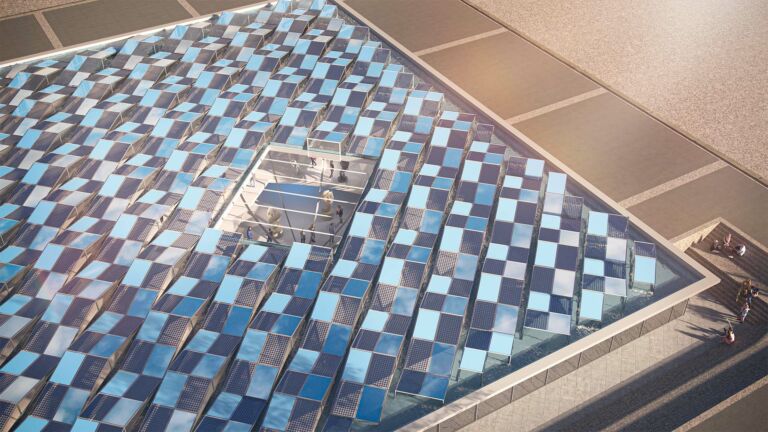
BIPV glass and carbon neutrality
The electrical magic of BIPV glass comes from photovoltaic cells sandwiched between two sheets of safety glass – but this energy-generating glass should not be confused with the conventional photovoltaic panels mounted on roofs.
BIPV glass: fully customisable energy-generating solutions
BIPV solutions are suitable for both the vision and opaque parts of the building facade. In the vision parts, the solar modules provide transparency. They incorporate visible photovoltaic cells whose size and layout can be adjusted in accordance with the architectural project. These modules are generally installed in roofs, louvres, canopies, carports and so on. For the opaque parts of the façade, the modules are opaque and conceal the solar cells while allowing the sun’s rays to pass through. Some of these products can also be produced in an infinite number of designs and colours. Since they are intended for spandrels and cladding, their great advantage is they make the remaining vertical surfaces usable for generating energy. In large buildings, these opaque areas account for about 30% of the surface area.
For both newbuilds and renovation projects, you can find a BIPV solution that delivers an ideal combination of energy efficiency and attractive design that can be deployed seamlessly in building facades. With its SunEwat range of energy-generating glass solutions, AGC Glass Europe is currently the only major glassmaker that offers a complete vision and opaque glass solutions with embedded photovoltaic cells.
BIPV glass for a significant economic and environmental return
In addition to generating power, solar glass can also deliver optimal thermal and acoustic comfort for occupants. The payback period for a BIPV solution with a moderate return is between 6.5 and 10 years depending on the transparency required by the project1.
In addition, BIPV glass boasts environmental performance and efficiency ratings in line with nearly zero-energy building (NZEB) standards, which means it helps meet green building certifications such as BREEAM and LEED. Moreover, BIPV glass solutions have become an essential tool the construction sector can use to meet European Green Deal targets. The goal is to reach carbon neutrality by 2050, but there is an intermediate step: the sector must aim for a 55% reduction in greenhouse gas emissions by 2030 (compared to 1990 levels). This massive challenge is all the more important for the building sector, which accounts for 36% of total emissions in the EU. The only way to achieve this goal is to leverage electricity-generating facade solutions, which are increasingly efficient, affordable and aesthetically pleasing.
1. Depending on its transparency, BIPV glazing has an estimated power of 0.120-0.180 kWp/m2. Based on a southeast facing facade in Brussels that offers a moderate return, the yield should be 650 kWh/kWp per year. Over the course of one year, the facade therefore generates between 78 and 117 kWh (= 0.120 or 0.180 x 650). At an electricity price of €0.20/kWh (European average in the first half of 2021), the output is valued at between €15.6 and €23.4/m². Since the extra cost of BIPV glazing compared to standard glazing is about €150/m2, the payback period is between 6.5 and 10 years.

